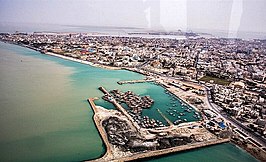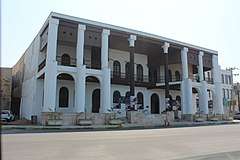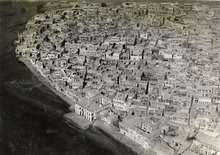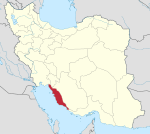Bushehr
Bushehr or Bushire (Persian: بوشهر [buːˈʃe(h)ɾ] (![]()
![]()
Bushehr بوشهر Bushire, Bandar Busher, Beh Ardasher | |
|---|---|
City | |
     Persian Gulf Coast in Bushehr | |
 Bushehr | |
| Coordinates: 28°58′N 50°50′E | |
| Country | |
| Province | Bushehr |
| County | Bushehr |
| Bakhsh | Central |
| Elevation | 8 m (26 ft) |
| Population (2016 Census) | |
| • Urban | 323,504 [1] |
| • Metro | 398,581 |
| Time zone | UTC+3:30 (IRST) |
| • Summer (DST) | UTC+4:30 (IRDT) |
| Climate | BSh |
| Website | www.bushehrcity.ir |
Bushehr lies in a vast plain running along the coastal region on the Persian Gulf coast of south-western Iran. It is built near the ancient port city of Rishahr (Sassanian, Riv Ardasher). It was the chief seaport of the country and is the administrative centre of its province. Its location is about 1,218 kilometres (757 mi) south of Tehran. Bushehr has a desert climate.
Bushehr was the main trade center of Iran in the past centuries. The city structures are traditional in style, modest in proportion and cost. Due to its lack of rail connection to the interior of the country and its shallow anchorage, it has lost its position as the primary port of Iran.
Etymology
During the Sassanian era, the name of the city was Ram Ardashir and later become Reyshahr, eventually this turned in to Bushehr, which is the current name of the city.[3]
History
To the south of the present city, at Reeshire, are the remains of an earlier Elamite (c 3000 BCE) settlement. During the Greek Macedonian Seleucid dynasty the city was refounded as Antiochia in Persis (Αντιόχεια της Περσίδος) by Seleucus Nicator. A few decades later the city was rebuilt by Seleucus's son Antiochus who transferred there colonists from Magnesia. Also the Seleucid king Antiochus stayed there for a while in 205 B.C. after his campaign to the eastern provinces (212 -205 B.C.). Antiochia remained under Greek Seleucid rule until circa 170 B.C. It was one of the most important ports of the Sasanian navy and was named after the first king of this dynasty, Ardashir I.
In the 5th century AD, Bushehr was the seat of the Nestorian Christian expansion into southern Iran.
In 1737 the Dutch East India Company opened a trading post in Bushehr, which lasted until 1753.

In 1763 the Arab governor of Bushehr Sheikh Nasr Al-Madhkur granted the British East India Company the right to build a base and trading post there. It was used as a base by the British Royal Navy in the late 18th century. In the 19th century, Bushehr became an important commercial port. It was occupied by British forces in 1856, during the Anglo-Persian War 1856–1857. Bushehr surrendered to the British on 9 December 1856.
It was occupied by the British again in 1915, this time due to the German Niedermayer–Hentig Expedition including Wilhelm Wassmuss.
Industries include fishing and a thermoelectric power plant, while the inland area (also called Bushehr) produces metalwork, rugs and other textiles, cement, and fertilizer. The Iranian navy maintains a base here.
Situation and significance
The strategic location of the city of Bushehr has been the main reason for the establishment of the port of Bushehr. During the 1st and 2nd Millennium BCE, the Peninsula of Bushehr was a thriving and flourishing seat of civilization called "Rey Shahr". Many relics have been found in this regard related to the Elamite era and the civilization of Shoush (Susa). These structures of "Rey Shahr" are said to be related to Ardeshir of Sassanid dynasty and "Rey Shahr" was formerly known by the name of Ram Ardeshir. Thereby through the passage of time came to be called Rey Shahr and thence Bushehr.
The Persian Gulf and consequently the province of Bushehr enjoys a remarkable situation with trade in addition to its remarkable situation regarding military affairs. For these reasons the Europeans were interested to take control of the region and the city of Bushehr. The Portuguese, invaded the city of Bushehr in 1506 CE and attempted to take the place of the Egyptian and the Venetian traders who were dominant in the region.
In 1734 Nader Shah of Afsharid dynasty chose it as the site for an Iranian naval base. During the Zand era, the region was a place for political challenges between different countries and political groups. When the Qajar dynasty replaced the Zand dynasty, they had less control on the region of the Persian Gulf, so the British influence in the region increased gradually.
At the end of the 18th century, the British and Dutch transferred their regional commercial offices to Bushehr, and during the 19th century the town was prominent as the home of the British political agent for the Persian Gulf. The Consulate General of British governed Bushehr for 20 years. This situation had lasted till 1913, and during the long battle between the Iranian and the British troops, the Iranians lost in 1857 and the British influence expanded to include all the Persian Gulf coast. But in 1913 the Iranians won the long battle. Britain moved its diplomatic and commercial center across the Persian Gulf to Bahrein in 1946. The city was economically depressed until the 1960s when the government initiated a major development program. In 1975 the government began building a nuclear power plant at Bushehr. This facility was only partially completed when it was bombed by Iraq during the Iran-Iraq War (1980–1988). When Germany, the initial backer of the plant, declined to complete it after the war, Iran tried to secure aid from other countries. In 1995, however, Russia signed an agreement to finish the plant.

Bushehr is one of the important ports in Persian Gulf which has an international airport, and highways connect the city to Ahvaz to the northwest and Shiraz to the northeast. A secondary coastal road links Bushehr to Bandar-e Abbas to the southeast. The old section of central Bushehr has many examples of traditional Persian Gulf architecture from the period 1870 to 1920.
Bushehr is an export market for the farm produce of the neighboring and fertile Fars Province. Bushehr's industries include seafood canneries, food-processing plants, and engineering firms. It has a population of 205,320 (2001 estimate).
Sports
Bushehr's two major Football teams are Shahin, which currently plays in the Persian Gulf Pro League, and Iranjavan, which plays in the Azadegan League.
Bushehr has a few Dragonboat teams. Their junior team Sokkan I.R. Iran participated in the 2014 Club Crew World Championships in Ravenna, Italy. They performed exceedingly well, placing third in both 200 meter and 500 meter in Junior A Open.
Geography
Climate
Bushehr has a hot semi-arid climate (Köppen: BSh) with a precipitation pattern resembling a mediterranean climate, albeit it is both too hot and dry for too long to qualify as such, by a wide margin, due to the threshold for hot climates being much higher in terms of required rainfall.
| Climate data for Bushehr (1951–2010) | |||||||||||||
|---|---|---|---|---|---|---|---|---|---|---|---|---|---|
| Month | Jan | Feb | Mar | Apr | May | Jun | Jul | Aug | Sep | Oct | Nov | Dec | Year |
| Record high °C (°F) | 30.0 (86.0) |
32.0 (89.6) |
38.0 (100.4) |
42.5 (108.5) |
47.0 (116.6) |
48.6 (119.5) |
50.0 (122.0) |
47.0 (116.6) |
46.0 (114.8) |
41.0 (105.8) |
34.5 (94.1) |
32.0 (89.6) |
50.0 (122.0) |
| Average high °C (°F) | 18.6 (65.5) |
20.2 (68.4) |
24.2 (75.6) |
29.6 (85.3) |
34.5 (94.1) |
36.4 (97.5) |
37.8 (100.0) |
38.1 (100.6) |
36.6 (97.9) |
32.9 (91.2) |
26.6 (79.9) |
21.0 (69.8) |
29.7 (85.5) |
| Daily mean °C (°F) | 14.5 (58.1) |
15.8 (60.4) |
19.3 (66.7) |
24.3 (75.7) |
29.0 (84.2) |
31.4 (88.5) |
33.1 (91.6) |
33.3 (91.9) |
30.8 (87.4) |
26.9 (80.4) |
21.3 (70.3) |
16.5 (61.7) |
24.7 (76.5) |
| Average low °C (°F) | 10.3 (50.5) |
11.4 (52.5) |
14.4 (57.9) |
18.9 (66.0) |
23.6 (74.5) |
26.3 (79.3) |
28.4 (83.1) |
28.4 (83.1) |
25.1 (77.2) |
20.9 (69.6) |
16.0 (60.8) |
12.0 (53.6) |
19.6 (67.3) |
| Record low °C (°F) | −1.0 (30.2) |
2.5 (36.5) |
5.0 (41.0) |
8.0 (46.4) |
14.0 (57.2) |
18.0 (64.4) |
21.0 (69.8) |
22.0 (71.6) |
17.0 (62.6) |
12.0 (53.6) |
5.0 (41.0) |
2.0 (35.6) |
−1.0 (30.2) |
| Average precipitation mm (inches) | 78.5 (3.09) |
31.8 (1.25) |
22.4 (0.88) |
8.6 (0.34) |
2.6 (0.10) |
0.0 (0.0) |
0.0 (0.0) |
0.3 (0.01) |
0.0 (0.0) |
5.7 (0.22) |
39.4 (1.55) |
78.7 (3.10) |
268.0 (10.55) |
| Average precipitation days (≥ 1.0 mm) | 5.9 | 3.4 | 3.1 | 1.7 | 0.4 | 0.0 | 0.0 | 0.0 | 0.0 | 0.5 | 2.7 | 5.3 | 22.0 |
| Average relative humidity (%) | 75 | 72 | 66 | 60 | 56 | 58 | 61 | 65 | 65 | 66 | 66 | 73 | 65 |
| Mean monthly sunshine hours | 199.1 | 195.4 | 217.4 | 232.0 | 292.5 | 329.7 | 314.0 | 320.9 | 293.8 | 279.0 | 227.3 | 193.5 | 3,094.6 |
| Source: Iran Meteorological Organization (records),[4] (temperatures),[5] (precipitation),[6] (humidity),[7] (days with precipitation),[8] (sunshine)[9] | |||||||||||||
Nuclear development
Bushehr is twelve kilometres from the site of the Bushehr Nuclear Power Plant being built in cooperation with Russia. The work was begun by the Bonn firm Kraftwerk Union A.G., a unit of Siemens AG, which contracted to build two nuclear reactors based on a contract worth $4 to $6 billion, signed in 1975.
Work stopped in January 1979, and Kraftwerk Union fully withdrew from the project in July 1979, with one reactor 50% complete, and the other reactor 85% complete. They said they based their action on Iran's non-payment of $450 million in overdue payments. The company had received $2.5 billion of the total contract. Their cancellation came following the 1979 Iranian Revolution. Iran subsequently requested that Siemens finish construction, but Siemens declined. Shortly afterwards Iraq invaded Iran and the nuclear programme was stopped until the end of the war. The reactors were damaged by multiple Iraqi air strikes between March 1984 and 1988.[10]
In 1995, Russia signed a contract to supply a light water reactor for the plant (the contract is believed to be valued between $700 million and $1.2 billion USD). The agreement calls for the spent fuel rods to be sent back to Russia for reprocessing. The plant started adding electricity to the national grid on 3 September 2011,[11] and was officially opened in a ceremony on 12 September 2011.[12]
Colleges and universities
- Persian Gulf University
- Bushehr University of Medical Sciences
- Islamic Azad University of Bushehr[13]
- Iran Nuclear Energy College
Postage stamps
See also
References
| Wikisource has the text of the 1911 Encyclopædia Britannica article Bushire. |
- https://www.amar.org.ir/english
- "Census of the Islamic Republic of Iran, 1385 (2006)". Islamic Republic of Iran. Archived from the original (Excel) on 2011-11-11.
- Xavier de Planhol, “BŪŠEHR i. THE CITY,” Encyclopædia Iranica, IV/6, pp. 569-572
-
- "Highest record temperature in Bushehr by Month 1951–2010". Iran Meteorological Organization. Retrieved April 8, 2015.
- "Lowest record temperature in Bushehr by Month 1951–2010". Iran Meteorological Organization. Retrieved April 8, 2015.
-
- "Average Maximum temperature in Bushehr by Month 1951–2010". Iran Meteorological Organization. Archived from the original on March 6, 2016. Retrieved April 8, 2015.
- "Average Mean Daily temperature in Bushehr by Month 1951–2010". Iran Meteorological Organization. Retrieved April 8, 2015.
- "Average Minimum temperature in Bushehr by Month 1951–2010". Iran Meteorological Organization. Archived from the original on March 6, 2016. Retrieved April 8, 2015.
- "Monthly Total Precipitation in Bushehr by Month 1951–2010". Iran Meteorological Organization. Retrieved April 8, 2015.
- "Average relative humidity in Bushehr by Month 1951–2010". Iran Meteorological Organization. Archived from the original on March 6, 2016. Retrieved April 8, 2015.
- "No. Of days with precipitation equal to or greater than 1 mm in Bushehr by Month 1951–2010". Iran Meteorological Organization. Archived from the original on March 6, 2016. Retrieved April 8, 2015.
- "Monthly total sunshine hours in Bushehr by Month 1951–2010". Iran Meteorological Organization. Archived from the original on March 6, 2016. Retrieved April 8, 2015.
- Pike, John. "Bushehr - Iran Nuclear Reactor". www.globalsecurity.org.
- "Iranian nuclear power station 'begins generating electricity'". The Guardian. London. Reuters. 4 September 2011. Retrieved 4 September 2011.
- "ran launches Bushehr nuclear power plant". RIA Novosti. 12 September 2011. Retrieved 14 September 2011.
- "خانه - دانشگاه آزاد اسلامی واحد بوشهر". www.iaubushehr.ac.ir.
Further reading
- William Milburn; Thomas Thornton (1825). "Gulph of Persia: Bushire". Oriental Commerce. London: Kingsbury, Parbury, and Allen.
- Josiah Conder (1830), "Busheer", Persia and China, Modern Traveller, London: James Duncan, OCLC 8888382
